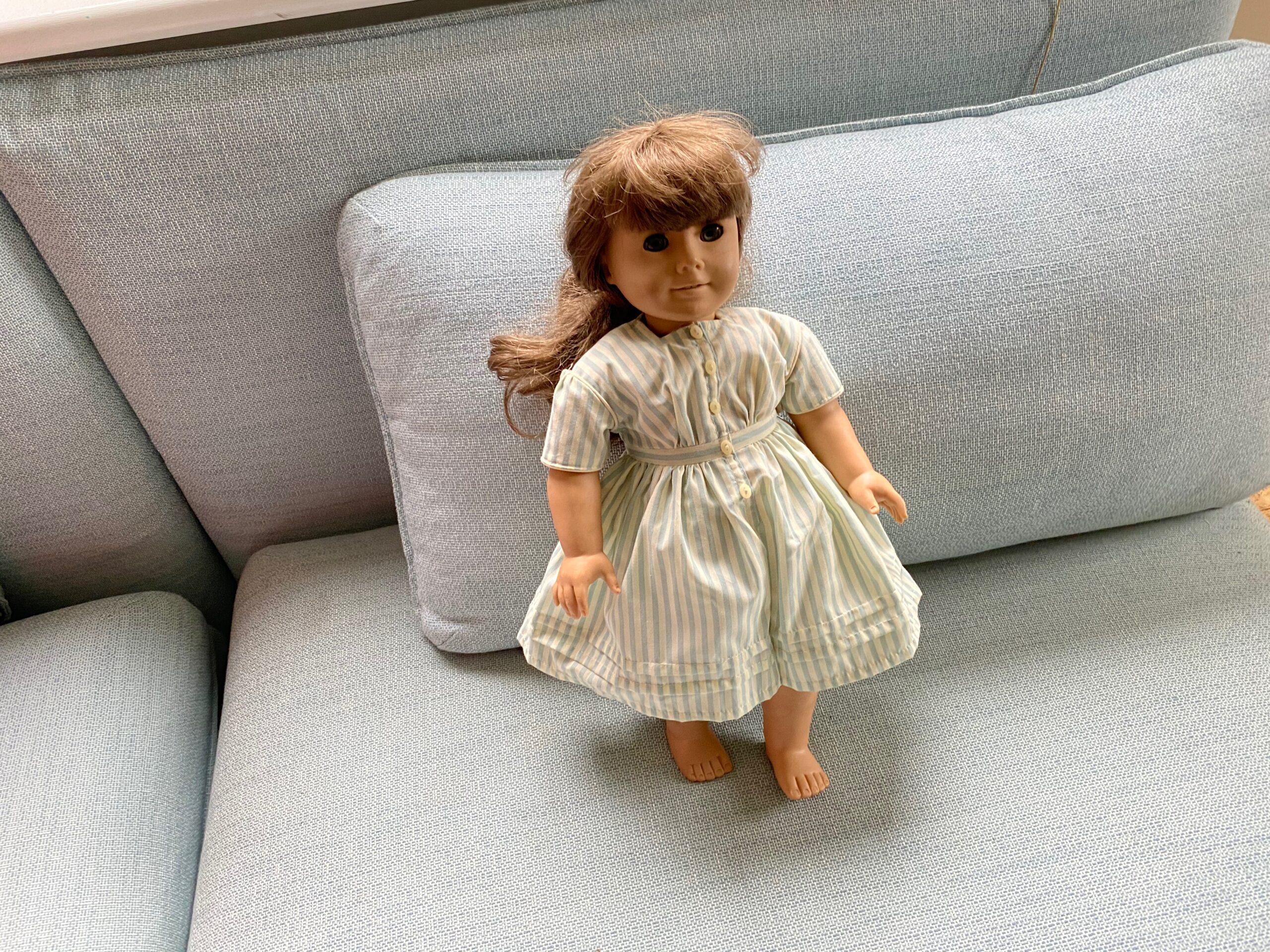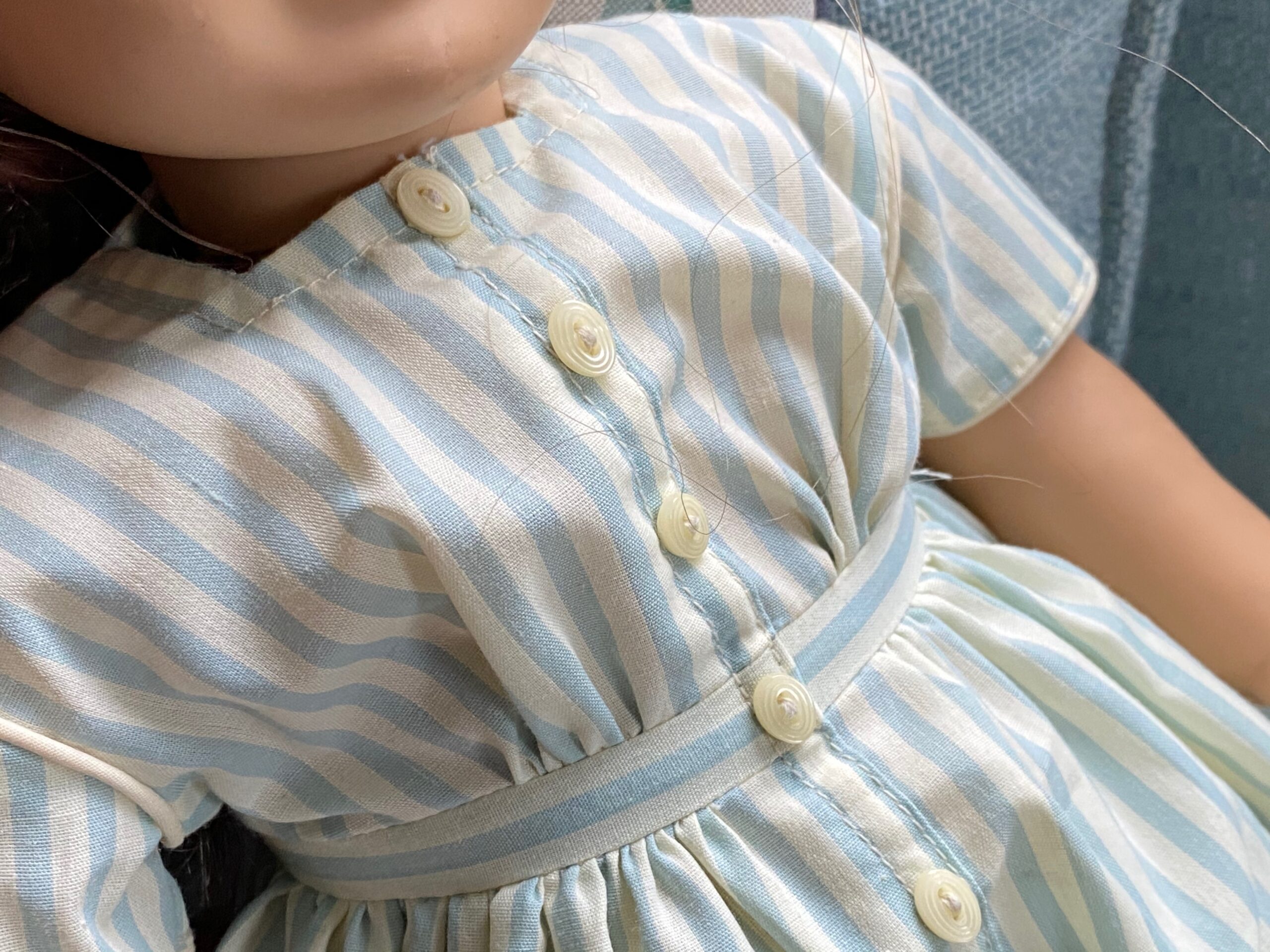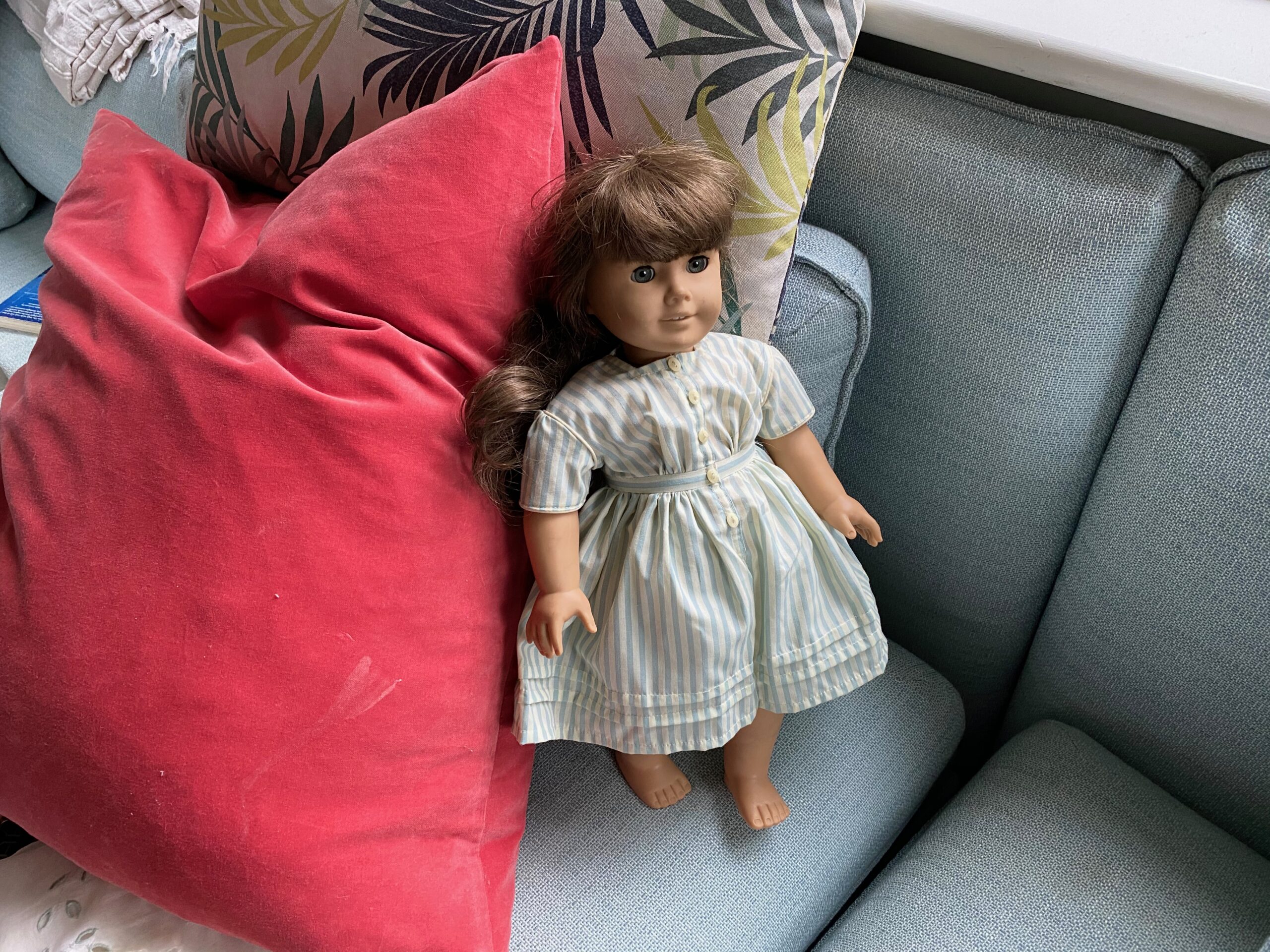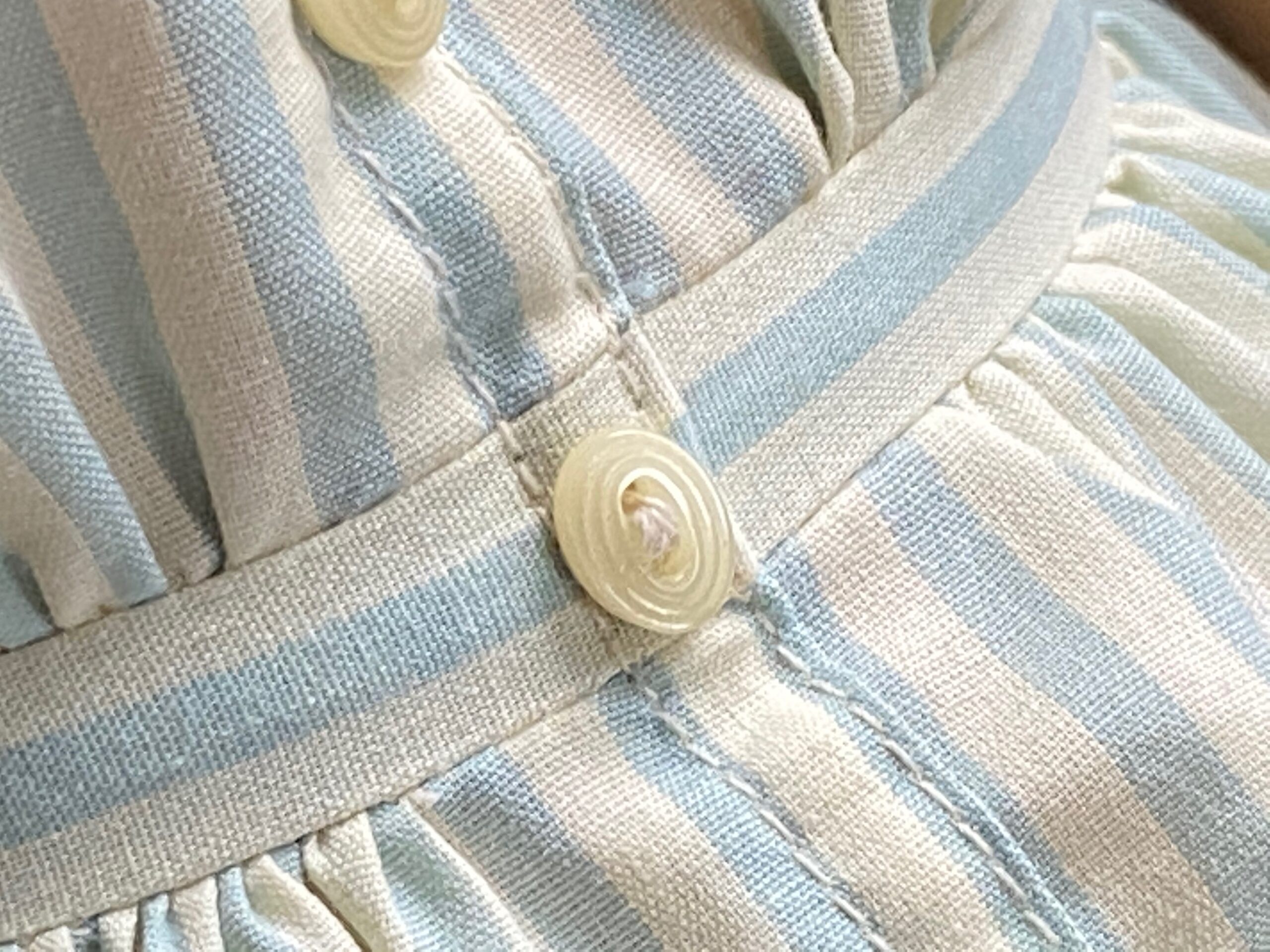Vintage American Girl dolls may have components with unsafe levels of Lead — use caution when giving them to young children
Vintage (1980s-1990s) American Girl dolls may have unsafe levels of Lead in their costumes or accessories.
While American Girl dolls I have tested over the years generally test negative for heavy metal toxicants (Lead, Mercury, Cadmium, Arsenic, and Antimony), I recently had the opportunity to test a vintage (1990s) American Girl doll that had several original outfits — including the one pictured on the doll here. As anticipated, and expected with most vintage plastic and metal buttons, the plastic buttons on this particular doll’s original vintage American Girl doll dress were positive for an unsafe level of Lead.
For those new to this website:
Tamara Rubin is a multiple-federal-award-winning independent advocate for childhood Lead poisoning prevention and consumer goods safety, and a documentary filmmaker. She is also a mother of Lead-poisoned children (two of her sons were acutely Lead-poisoned in 2005). Since 2009, Tamara has been using XRF technology (a scientific method used by the U.S. Consumer Product Safety Commission) to test consumer goods for toxicants (specifically heavy metals — including Lead, Cadmium, Mercury, Antimony, and Arsenic). All test results reported on this website are science-based, accurate, and replicable. Items are tested multiple times to confirm the test results for each component tested. Tamara’s work was featured in Consumer Reports Magazine in February of 2023 (March 2023 print edition).
The buttons on the dress pictured had unsafe levels of Lead.
Buttons of outfits on dolls (dolls intended for use by young children) that test positive for a high level of Lead are a concern because of the potential impact if mouthed or swallowed (as opposed to any potential impact from handling with normal use as intended — taking the clothes on and off the doll). The amount of Lead considered unsafe in any single component of a modern (newly-manufactured, post-2011) toy intended for use by children is anything 90 ppm Lead or higher in the paint or coating of a component; as well as anything 100 ppm Lead or higher in the substrate of a component. Because the buttons pictured are unpainted plastic, the 100 ppm Lead limit would apply if this were a newly-manufactured item.
How much Lead did these buttons have?
The specific buttons pictured had a Lead level (when tested with a high-precision XRF instrument designed to test for Lead in consumer goods) of 13,500 ppm Lead. These buttons also tested positive for trace levels of Cadmium, Mercury, and Antimony. Again — to reiterate — the buttons were the only component of the doll and her various outfits (dresses, shoes, etc.) that tested positive for any toxic heavy metals. (Her eyeglasses were also positive for Lead, but not anything else on the doll nor any part of her clothing other than the buttons. I will write more about her eyeglasses separately.) American Girl is generally a terrific company, and per compliance requirements with the Consumer Product Safety Improvement Act, I would not expect to find toxicants in any components of the dolls or clothing on their dolls produced after 2011.
Here is the exact full XRF reading set for the buttons pictured.
- Lead (Pb): 13,500 +/- 300 ppm
- Cadmium (Cd): 26 +/- 6 ppm
- Mercury (Hg): 127 +/- 27 ppm
- Antimony (Sb): 86 +/- 14 ppm
- Silver (Ag): 18 +/- 4 ppm
- Barium: non-detect
- Chromium: non-detect
Takeaway/ Simple Solution
- If these vintage dolls (from the 1980s or 1990s) are sitting on the shelf in your home, they are not a huge concern.
- If the doll is being actively played with by your children and you are still using vintage clothing with these dolls, please consider setting the vintage clothes aside and picking up some new clothes for your vintage American Girl doll. Here are some links to new (likely toxicant-free) American Girl doll outfits (please confirm that they are the right size for your doll before purchasing!):
- Note: For vintage, in this case, we are talking about the 1980s and possibly as late as the 1990s. (Based on a quick Wikipedia search, it looks like American Girl dolls were first released in 1986.)
What else should we do about this?
Lead Safe Mama readers are collaborative partners with us on this work and so I would also like to suggest that IF you are a hardcore American Girl doll fan (which I know many of you are), please consider bringing this to their attention. (They might even swap you out some new clothes for your vintage clothes — although I understand that might impact the value of your doll.)
Important to note:
I have NOT conducted extensive testing on the clothes for the American Girl dolls (noting variations in different production years and different colors of plastic, for example) and while this concern holds true with the specific outfit pictured (and plastics containing toxicants are fairly common in the 1980s and 1990s — all the way back through to the 1960s as well), I don’t know how many of the American Girl doll outfits have concerning plastic components or accessories. Nor do I know which colors, styles, or years of production might be of concern. I will do my best in the coming months to test more of these dolls and their clothes to get a better sense of the scope of this concern. If you have some vintage 1980s or ’90s outfits from theses dolls (especially if you know exactly what year they were manufactured or purchased!) and would like to send them to me for testing, please do (send to: tamararubin@mac.com), with a note containing images of the outfits. To learn more about the testing we conduct and report here on this website, please check out this link.
Here’s my Amazon affiliate link for the American Girl doll store on Amazon: https://amzn.to/33sBZJO.
As always, thank you for reading and sharing this work. It is never my intention to cause panic or alarm. Lead Safe Mama, LLC’s goal is always focused on giving parents specific science-based information — and whenever possible, making sure this information is accompanied by safer alternatives (especially in cases where toxicants are found in consumer goods intended for use by children or intended for use with food). Hopefully, this research will help you and your friends make informed decisions for your children. Please let me know if you have any questions and I will do my best to answer them personally as soon as I have a moment.
Tamara Rubin
#LeadSafeMama
Amazon links are affiliate links. If you purchase something after clicking on one of these links, Lead Safe Mama, LLC may receive a small percentage of what you spend at no extra cost to you.

Never Miss an Important Article Again!
Join our Email List













Do you know if the dolls themselves are safe for play? I have a bitty baby and several dolls from the 90’s and don’t know if my little one should play with them or not?
Hi! As the other person asked, can you clarify on the doll itself? I also have several dolls and bitty baby from the 90s. Thank you!
Sure, it is a circa 1990s bitty baby (not sure exact year. It is marked Pleasant Company
Hi I would like to know if the dolls themself are safe! I just threw away all the vintage clothing and accessories!
The dolls I have tested so far have been free of: Mercury, Cadmium, Arsenic, Antimony and Lead -but I have only tested a handful of them and I don’t know years of manufacture for all – so it’s possible that some earlier ones test positive for toxicants. I would not rule that out without further testing given they have been shown to have toxicants in the older accessories (pretty consistently.)
You should be ashamed of yourself for posting this. I doubt the accuracy of your testing methods and who knows what that doll has rubbed up against over the years. You are spreading fear and I assume making a lot of money from all these ads on your website. You are sick and this is cruel. HOW DARE YOU!
I posted your comment on Facebook and Instagram – you may want to check out the responses – they are fun.
T
She uses XRF technology which is very accurate for testing for toxic metals. It is very expensive technology and not usually available for the average consumer (it is extremely expensive). So this is actually very helpful.
Hi! What about the German doll brand- Gotz, they pretty much look the same, and Gotz states that their dolls are free from nasty things and meet all the regulations. Thanks!
Can you specify which dolls you have tested? I wonder if different skin tones would affect whether or not heavy metals were used. I have Kirsten and Addy from the mid ‘90s, and want to make sure both dolls are safe to pass on.